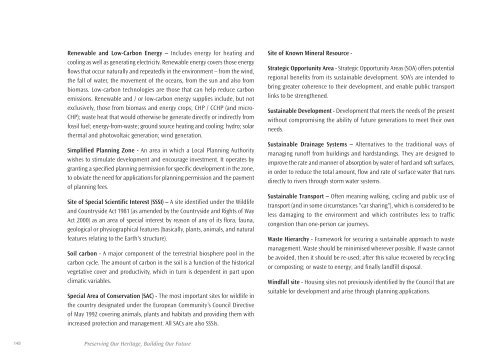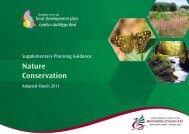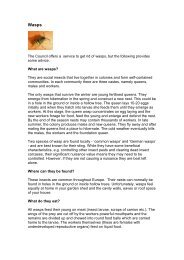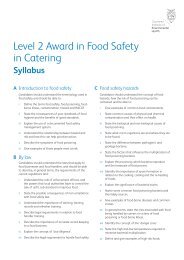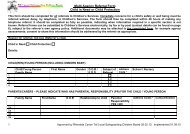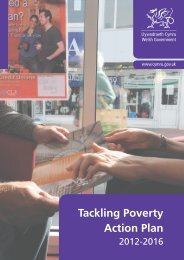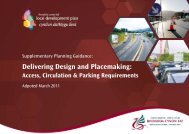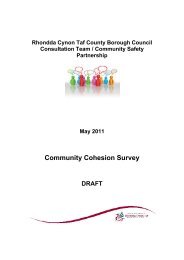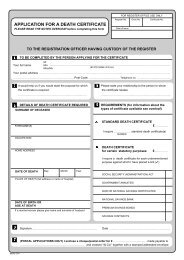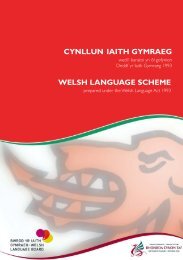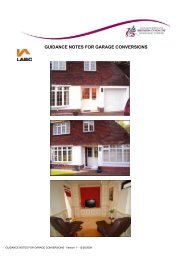Deposit Draft Local Development Plan - Rhondda Cynon Taf
Deposit Draft Local Development Plan - Rhondda Cynon Taf
Deposit Draft Local Development Plan - Rhondda Cynon Taf
- No tags were found...
Create successful ePaper yourself
Turn your PDF publications into a flip-book with our unique Google optimized e-Paper software.
Renewable and Low-Carbon Energy – Includes energy for heating andcooling as well as generating electricity. Renewable energy covers those energyflows that occur naturally and repeatedly in the environment – from the wind,the fall of water, the movement of the oceans, from the sun and also frombiomass. Low-carbon technologies are those that can help reduce carbonemissions. Renewable and / or low-carbon energy supplies include, but notexclusively, those from biomass and energy crops; CHP / CCHP (and micro-CHP); waste heat that would otherwise be generate directly or indirectly fromfossil fuel; energy-from-waste; ground source heating and cooling; hydro; solarthermal and photovoltaic generation; wind generation.Simplified <strong>Plan</strong>ning Zone - An area in which a <strong>Local</strong> <strong>Plan</strong>ning Authoritywishes to stimulate development and encourage investment. It operates bygranting a specified planning permission for specific development in the zone,to obviate the need for applications for planning permission and the paymentof planning fees.Site of Special Scientific Interest (SSSI) – A site identified under the Wildlifeand Countryside Act 1981 (as amended by the Countryside and Rights of WayAct 2000) as an area of special interest by reason of any of its flora, fauna,geological or physiographical features (basically, plants, animals, and naturalfeatures relating to the Earth's structure).Soil carbon - A major component of the terrestrial biosphere pool in thecarbon cycle. The amount of carbon in the soil is a function of the historicalvegetative cover and productivity, which in turn is dependent in part uponclimatic variables.Special Area of Conservation (SAC) - The most important sites for wildlife inthe country designated under the European Community’s Council Directiveof May 1992 covering animals, plants and habitats and providing them withincreased protection and management. All SACs are also SSSIs.Site of Known Mineral Resource -Strategic Opportunity Area - Strategic Opportunity Areas (SOA) offers potentialregional benefits from its sustainable development. SOA’s are intended tobring greater coherence to their development, and enable public transportlinks to be strengthened.Sustainable <strong>Development</strong> - <strong>Development</strong> that meets the needs of the presentwithout compromising the ability of future generations to meet their ownneeds.Sustainable Drainage Systems – Alternatives to the traditional ways ofmanaging runoff from buildings and hardstandings. They are designed toimprove the rate and manner of absorption by water of hard and soft surfaces,in order to reduce the total amount, flow and rate of surface water that runsdirectly to rivers through storm water systems.Sustainable Transport – Often meaning walking, cycling and public use oftransport (and in some circumstances "car sharing"), which is considered to beless damaging to the environment and which contributes less to trafficcongestion than one-person car journeys.Waste Hierarchy - Framework for securing a sustainable approach to wastemanagement. Waste should be minimised wherever possible. If waste cannotbe avoided, then it should be re-used; after this value recovered by recyclingor composting; or waste to energy; and finally landfill disposal.Windfall site - Housing sites not previously identified by the Council that aresuitable for development and arise through planning applications.148Preserving Our Heritage, Building Our Future


